一般过去时的概念
一般过去时与过去完成时的区别

一般过去时与过去完成时的区别一般过去时和过去完成时都是英语中表示过去的时态,但它们在使用和表达上有着不同的区别。
本文将从不同的角度来探讨一般过去时和过去完成时的区别。
一、时间概念1. 一般过去时:一般过去时用来表示过去某个具体的动作或状态。
常常与表示过去的时间状语连用,如:yesterday(昨天)、last week(上周)、in 1999(在1999年)、three days ago(三天前)等。
2. 过去完成时:过去完成时用来表示过去某个动作或状态在另一个过去的时间点之前已经完成。
通常有两个动作或状态,其中一个发生在另一个之前。
常常与表示过去的时间状语连用,如:before(之前)、after(之后)、by the time(到…之时)等。
二、动词形式1. 一般过去时:一般过去时的谓语动词通常是由动词的过去式构成。
例如:play(玩)- played(玩过);go(去)- went(去过);study(学习)- studied(学习过)等。
2. 过去完成时:过去完成时的谓语动词通常是由助动词 had 和动词的过去分词构成。
例如:have(有)- had (曾有);eat(吃)- eaten (吃过);write(写)- written(写过)等。
三、用法1. 一般过去时:一般过去时用来描述过去的动作或状态,强调动作或状态的完成。
例如:I watched a movie last night.(昨晚我看了一部电影。
)He lived in Beijing for ten years.(他在北京住了十年。
)2. 过去完成时:a. 表示过去某个动作在另一个过去的时间点之前已经完成。
例如:I had finished my homework by the time he arrived.(他到达时,我已经完成了作业。
)b. 表示过去某个动作在过去某个时间点之前已经完成,但没有明确指出这个时间点。
例如:She had already left when I arrived.(我到达时她已经离开了。
一般过去时
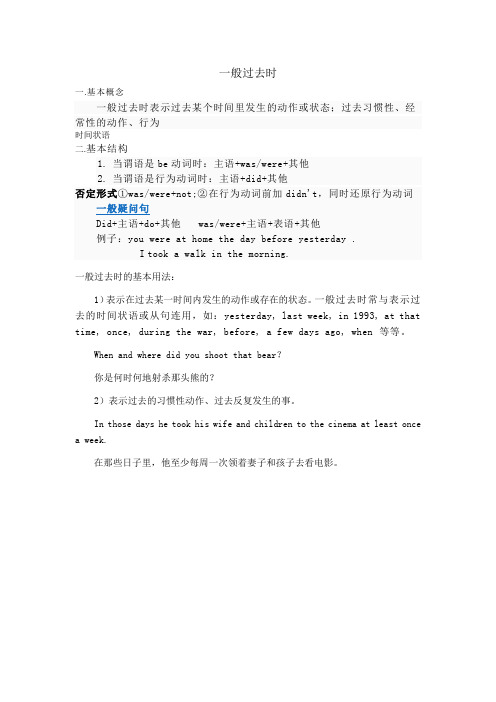
一般过去时一.基本概念一般过去时表示过去某个时间里发生的动作或状态;过去习惯性、经常性的动作、行为时间状语二.基本结构1.当谓语是be动词时:主语+was/were+其他2.当谓语是行为动词时:主语+did+其他否定形式①was/were+not;②在行为动词前加didn't,同时还原行为动词一般疑问句Did+主语+do+其他 was/were+主语+表语+其他例子:you were at home the day before yesterday .I took a walk in the morning.一般过去时的基本用法:1)表示在过去某一时间内发生的动作或存在的状态。
一般过去时常与表示过去的时间状语或从句连用,如:yesterday, last week, in 1993, at that time, once, during the war, before, a few days ago, when 等等。
When and where did you shoot that bear?你是何时何地射杀那头熊的?2)表示过去的习惯性动作、过去反复发生的事。
In those days he took his wife and children to the cinema at least once a week.在那些日子里,他至少每周一次领着妻子和孩子去看电影。
一般过去式的练习题一.动词填空,用所给动词的适当形式填空1. Tom and Mary ___________ (come) to China last month.2. Mary __________ (read) English yesterday morning.3. There _________ (be) no one here a moment ago.4. I ___________ (call) Mike this morning.5. Tom ___________ (begin) to learn Chinese last year.6. Last week we _________ (pick) many apples on the farm.7. My mother ________________ (not do) housework yesterday.8. She watches TV every evening. But she _______________ (not watch) TV last night.9. ________ your father ________ ( go ) to work every day last year?10. —What time _______ you _______ (get) to Beijing yesterday?—We __________ (get) to Beijing at 9:00 in the evening.二. 选择填空1. _____ he ________ a good rest? No, he didn’t.A. Have, hadB. Did, haveC. Did, hadD. Had, had2. Mr. Black was late because he _______ his way.A. lostedB. had lostC. has lostD. lost3. When _________ Lee ________ school this morning?A. had, got toB. did, get toC. did, getD. did, got to4. Will you please say it again? I ________ quite _______ you.A. didn’t, hearB. haven’t, heardC. didn’t, heardD. hadn’t, heard5. ______ you ________ at six o’clock yesterday?A. Do ,get upB. Did, get upC. Do, got upD. Did, got up6.What did you see _________?A. nowB. every dayC. since 1990D. just now7.He went into the room and _______ the door.A. lockB. lockingC. locksD. locked8. —What _____ you _______ last week?—I bought a bag.A. did ,buyB. did , boughtC. do, buyD. do, bought9. —_____ he ____ his lunch?— Yes, he did.A. Have ,hadB. Had, hasC. Did, haveD. Did, had10.—Did the thieves _____ into the car?—No, they______.A. fell, didn’tB. fall, didC. jump, didn’tD. jump, did11. —When did May come back from Hong Kong?—She _____ from Hong Kong last Friday.A. come backB. comes backC. returned backD. came back12. ____ she _____ this dictionary in the bookshop nearby last week?A. Did, buyB. Does, buyC. Did, boughtD. Does, buys13. He ____ to the station this morning and was______ for the train.A. hurry, in timeB. hurries, on timeC. hurried, in timeD. hurried, at time14. —Have you seen him today?—Yes, I ____ him this morning.A. has seenB. seeC. will seeD. saw15. He ______ worried when he heard the news.A. isB. wasC. doesD. did16. There _____ a telephone call for my brother Steven yesterday?A. isB. areC. wasD. were17. Liu Fengwei _____ three yuan for the lost library book.A. paidB. payC. spentD. lost18. He ____ in this school in 1958.A. taughtB. has taughtC. teachesD. had taught19. They _____ tired so they stopped ____ a rest.A. are, haveB. were, haveC. were, to haveD. are, having20. Yesterday I _____ in bed all day because I had a fever.A. layB. lieC. laidD. lain21. Hello, Mike. It’s you. I _____ you ______ in Beijing. How long have you been here?A. don’t know, we reB. hadn’t known, areC. haven’t known, areD. didn’t know, were22. As soon as we saw his face, we ___ the news ___ bad.A. knew, wasB. know, wereC. know, wasD. knows,。
一般过去时

三.一般过去时(simple past tense)1.概念一般过去时表示过去某一时刻,某一段时间发生的动作或存在的状态。
一般过去时用动词的过去式表示。
2.构成一般过去时用动词的过去式表示。
be的过去式有was,were两种; have 的过去式是had;规则动词的过去式在动词词尾加-ed,具体构成规则如下:1)一般情况,动词后加ed,例词work-worked,clean-cleaned,play-played,wash-washed2)以不发音的e结尾,-d,例词live-lived,move-moved,hope-hoped,arrive-arrived 3)以辅音字母+y结尾,变y为 i再加-ed,例词study-studied,carry-carried,cry-cried,identify-identified 4)以辅音字母结尾的重读闭音节,双写最后一个辅音字母加-ed,例词plan-plannedstop-stopped,beg-begged,grab-grabbed 3.用法 (1) 表示发生在过去的动作或存在的状态。
如:He went shopping with his friends last week.They arrived ten minutes ago.He became a hotel manager ten years ago.Did you go to the concert last night?(2) 表示在过去经常发生的动作或习惯动作。
如:He visited his grandparents once a month last year.She usually went to work by car last year.When I was at school, I always went to school by bus.4.如何识别一般过去时常见的标志词有:1). yesterday, the day before yesterday.2). last week / year / month / term …(简称last系列)3). two hours ago, three years ago, a moment ago…(简称ago系列)4). in / on + 过去的年/月/日,如 in 1999, on April, 20055). just now, once upon a time, one day…5.易错点例析:(1)——Your phone number again? I _________ quite catch it.——It’s 4331577A. didn’tB. couldn’tC. don’tD. can’t(2)——Mr. Smith isn’t coming tonight.——But he _________.A. promisesB. promisedC. will promiseD. had promised(3) ——Hey, look where you are going!——Oh, I’m terribly sorry. _________.A. I’m not noticingB. I wasn’t noticingC. I haven’t noticedD. I don’t notice(4) ——Oh it’s you ! I _________ you.——I’ve had my hai r cut.A. didn’t realizeB. haven’t realizedC. didn’t recognizeD. don’t recognized(5) ——Since you’ve agreed to go, why aren’t you getting ready?——But I _________ that you would have me start at once.A. don’t realizeB. didn’t realizeC. hadn’t realizedD. haven’t realized(6) ——It’s twelve o’clock, I think I must be off now.——Oh, really? I _________ it at all.A. don’t realizeB. haven’t realizedC. didn’t realizeD. hadn’t realizedKey:ABBCBC6.中考真题及模拟(2009朝阳区一模)He went into his room, _______ the light and began to work.A. has turned onB. will turn onC. turns onD. turned on(2009海淀一模)——What’s the best food have you had in Beijing, Alex?——Roast duck! I _________to a famous restaurant to have it last week.A. have goneB. goC. will goD. went(2009宣武区一模)——Do you know how many gold medals the 23-year-old Michael Phelps _____________at the 2008 Summer Olympic Games?——Eight.A. winB. winsC. wonD. has won(2008北京)We were in Qingdao last week and __________ great fun there.A. will haveB. have hadC. hadD. have(2007北京)——What did you do after school yesterday?——I _________basketball with my friends.A. playB. playedC. will playD. am playing(2005北京)---Hi, Kate. You look tired. What’s the matter?---I ______well last night.A. didn’t sleepB. don’t sleepC. haven’t sleptD. won’t sleep (2008四川泸州)Yesterday,Tony’s family _________ a good time.A. hasB. haveC. had(2007湖南湘潭)I’m sorry you’ve missed the train. It _______10 minutes ago.A. leftB. has leftC. had left(2007福州)——Mr Green, __________you________ Three Lanes and Alleys(三坊七巷)last Sunday?——No, but I’ll visit them next week.A. will; go toB. have; been toC. did; go toD. have; gone to (2007浙江)——What did the teacher say just now?——He __________us not to play computer games all day.A. tellsB. toldC. has toldD. is told(2007江西)——Inventors have changed the way we live.——So they are famous for the great things they _________.A. doB. didC. are doingD. had done(06江西)——Where’s the cake I made this morning?——We _______ it, mum. Can you make another one for us?A. ateB. eatC. will itD. were eating。
一般过去时的定义以及用法概念
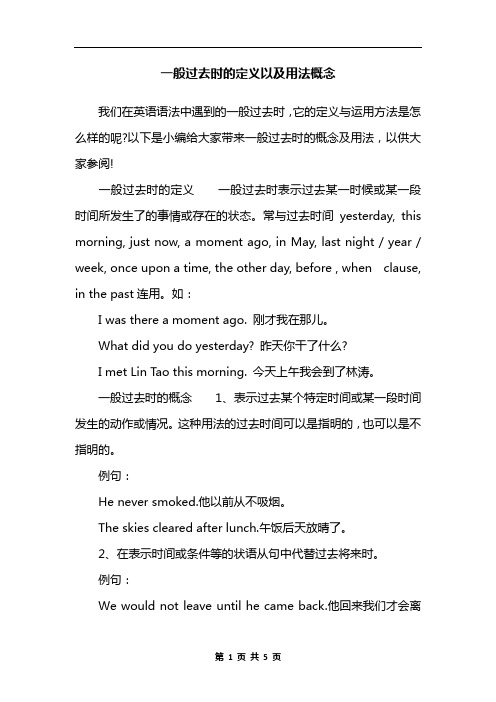
一般过去时的定义以及用法概念我们在英语语法中遇到的一般过去时,它的定义与运用方法是怎么样的呢?以下是小编给大家带来一般过去时的概念及用法,以供大家参阅!一般过去时的定义一般过去时表示过去某一时候或某一段时间所发生了的事情或存在的状态。
常与过去时间yesterday, this morning, just now, a moment ago, in May, last night / year / week, once upon a time, the other day, before , when clause, in the past连用。
如:I was there a moment ago. 刚才我在那儿。
What did you do yesterday? 昨天你干了什么?I met Lin Tao this morning. 今天上午我会到了林涛。
一般过去时的概念1、表示过去某个特定时间或某一段时间发生的动作或情况。
这种用法的过去时间可以是指明的,也可以是不指明的。
例句:He never smoked.他以前从不吸烟。
The skies cleared after lunch.午饭后天放晴了。
2、在表示时间或条件等的状语从句中代替过去将来时。
例句:We would not leave until he came back.他回来我们才会离开。
I didnt go to the party that evening as I started the next day.那天晚上我没有去参加聚会,因为我第二天就要出发。
3、表示现在时间。
这种用法使句子在语气上较为婉转客气,能这样用的动词为数不多,如:hope,wish,want,wonder,think,intend 等。
例句:I hoped you would come and have dinner with us.我希望你能来和我们一起吃饭。
一般过去时的含义
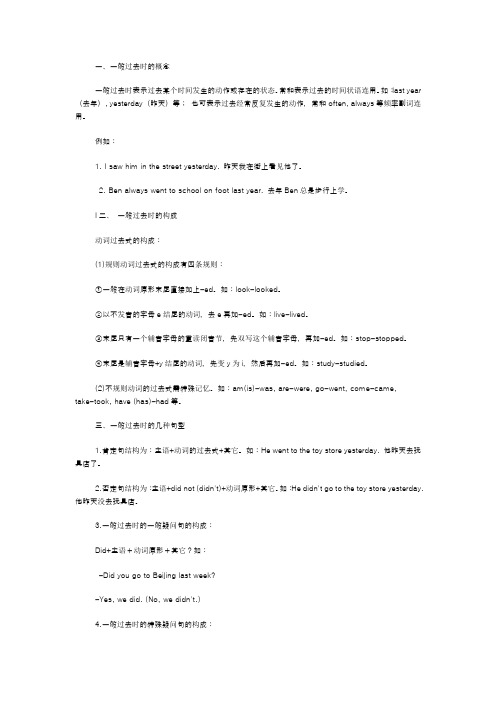
一、一般过去时的概念一般过去时表示过去某个时间发生的动作或存在的状态。
常和表示过去的时间状语连用。
如:last year (去年), yesterday(昨天)等;也可表示过去经常反复发生的动作,常和often, always等频率副词连用。
例如:1. I saw him in the street yesterday. 昨天我在街上看见他了。
2. Ben always went to school on foot last year. 去年Ben总是步行上学。
I二、一般过去时的构成动词过去式的构成:(1)规则动词过去式的构成有四条规则:①一般在动词原形末尾直接加上-ed。
如:look-looked。
②以不发音的字母e结尾的动词,去e再加-ed。
如:live-lived。
③末尾只有一个辅音字母的重读闭音节,先双写这个辅音字母,再加-ed。
如:stop-stopped。
④末尾是辅音字母+y结尾的动词,先变y为i,然后再加-ed。
如:study-studied。
(2)不规则动词的过去式需特殊记忆。
如:am(is)-was, are-were, go-went, come-came,take-took, have (has)-had等。
三、一般过去时的几种句型1.肯定句结构为:主语+动词的过去式+其它。
如:He went to the toy store yesterday. 他昨天去玩具店了。
2.否定句结构为:主语+did not (didn't)+动词原形+其它。
如:He didn't go to the toy store yesterday. 他昨天没去玩具店。
3.一般过去时的一般疑问句的构成:Did+主语+动词原形+其它?如:-Did you go to Beijing last week?-Yes, we did. (No, we didn't.)4.一般过去时的特殊疑问句的构成:疑问词+did+主语+动词原形+其它?如:1) -What did you do last night(昨晚)?-I did my homework.2) -Where did you go last week?-I went to Shanghai with my parents.一般过去时口诀一般过去时并不难,表示过去动作、状态记心间。
一般过去时的使用范围

一般过去时的使用范围摘要:一、一般过去时的定义与应用场景二、一般过去时的使用范围1.动作或状态发生在过去某个具体时间2.描述过去习惯性动作或状态3.转述他人过去的经历或陈述事实4.表达过去某个时间点的客观事实正文:一般过去时(Simple Past Tense)是英语中的一种时态,表示过去某个时间发生的动作或存在的状态。
它在日常交流、书面表达等各种场景中都有广泛的应用。
下面我们来详细了解一下一般过去时的使用范围。
1.动作或状态发生在过去某个具体时间一般过去时可以用来描述过去某个具体时间点发生的动作或状态。
例如:- I watched a movie yesterday.(我昨天看了一部电影。
)- She visited her grandparents last week.(她上周拜访了她的祖父母。
)2.描述过去习惯性动作或状态一般过去时还可以表示过去某个时间段内经常发生的动作或存在的状态。
例如:- He usually went to the gym after work.(他下班后通常去健身房。
)- She was a good student in high school.(她高中时是个优秀的学生。
)3.转述他人过去的经历或陈述事实在转述他人过去的经历或陈述事实时,我们也可以使用一般过去时。
例如:- He said he had visited many countries.(他说他去过很多国家。
)- She explained that she had studied English for five years.(她解释说她学英语已经五年了。
)4.表达过去某个时间点的客观事实一般过去时还可以用来表达过去某个时间点的客观事实。
例如:- The sun rose in the east.(太阳从东方升起。
)- The plane landed safely at the airport.(飞机安全降落在机场。
一般过去式的定义
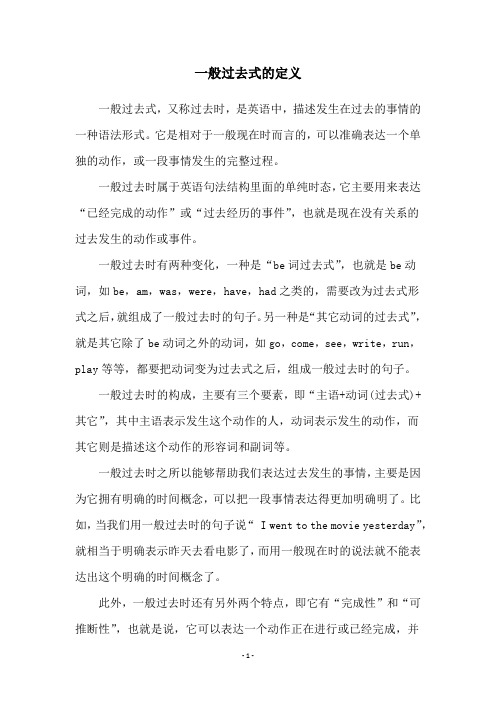
一般过去式的定义一般过去式,又称过去时,是英语中,描述发生在过去的事情的一种语法形式。
它是相对于一般现在时而言的,可以准确表达一个单独的动作,或一段事情发生的完整过程。
一般过去时属于英语句法结构里面的单纯时态,它主要用来表达“已经完成的动作”或“过去经历的事件”,也就是现在没有关系的过去发生的动作或事件。
一般过去时有两种变化,一种是“be词过去式”,也就是be动词,如be,am,was,were,have,had之类的,需要改为过去式形式之后,就组成了一般过去时的句子。
另一种是“其它动词的过去式”,就是其它除了be动词之外的动词,如go,come,see,write,run,play等等,都要把动词变为过去式之后,组成一般过去时的句子。
一般过去时的构成,主要有三个要素,即“主语+动词(过去式)+其它”,其中主语表示发生这个动作的人,动词表示发生的动作,而其它则是描述这个动作的形容词和副词等。
一般过去时之所以能够帮助我们表达过去发生的事情,主要是因为它拥有明确的时间概念,可以把一段事情表达得更加明确明了。
比如,当我们用一般过去时的句子说“ I went to the movie yesterday”,就相当于明确表示昨天去看电影了,而用一般现在时的说法就不能表达出这个明确的时间概念了。
此外,一般过去时还有另外两个特点,即它有“完成性”和“可推断性”,也就是说,它可以表达一个动作正在进行或已经完成,并且可以推断出某种结果。
比如,用一般过去时的句子说“I ate an ice-cream”,就可以推断出我已经吃了冰淇淋,并且吃完了。
因此,可以说一般过去时是英语句法结构中最常用的时态之一,它的主要用途就是表达在过去发生的一个或一段事情,而它的特点,就是具有明确的时间概念,具有完成性和可推断性。
只要把动词变为过去式,就可以正确地表达这样的场景了。
一般过去时详解
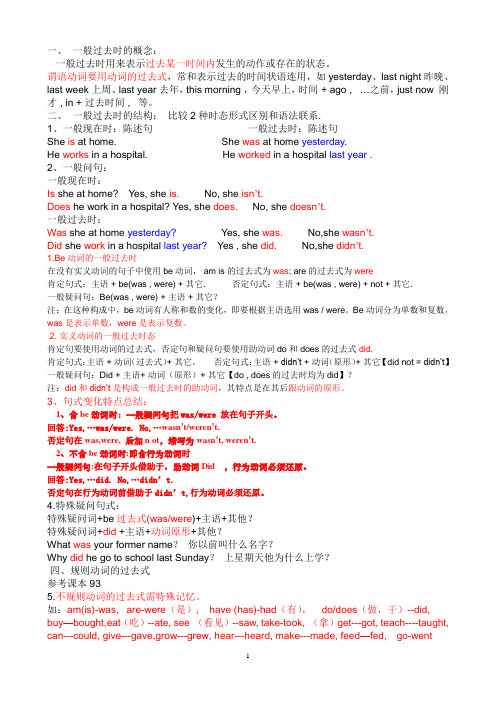
一、一般过去时的概念:一般过去时用来表示过去某一时间内发生的动作或存在的状态。
谓语动词要用动词的过去式,常和表示过去的时间状语连用,如yesterday、last night昨晚、last week上周、last year去年,this morning ,今天早上,时间 + ago , …之前,just now 刚才 , in + 过去时间 , 等。
二、一般过去时的结构:比较2种时态形式区别和语法联系.1、一般现在时:陈述句一般过去时:陈述句She is at home. She was at home yesterday.He works in a hospital. He worked in a hospital last year .2、一般问句:一般现在时:Is she at home? Yes, she is.No, she isn’t.Does he work in a hospital? Yes, she does. No, she doesn’t.一般过去时:Was she at home yesterday? Yes, she was. No,she wasn’t.Did she work in a hospital last year? Yes , she did. No,she didn’t.1.Be动词的一般过去时在没有实义动词的句子中使用be动词, am is 的过去式为was; are的过去式为were肯定句式:主语 + be(was , were) + 其它. 否定句式:主语 + be(was , were) + not + 其它.一般疑问句:Be(was , were) + 主语 + 其它?注:在这种构成中,be动词有人称和数的变化,即要根据主语选用was / were。
Be动词分为单数和复数,was是表示单数,were是表示复数。
2. 实义动词的一般过去时态肯定句要使用动词的过去式,否定句和疑问句要使用助动词do和 does 的过去式 did.肯定句式:主语 + 动词(过去式)+ 其它。
初中英语语法——一般过去时知识点总结归纳

初中英语语法——一般过去时知识点总结归纳一般过去时——表示过去发生的动作或事件。
概念: 1) 表示过去某个时间发生的动作或存在的状态。
常和表示过去的时间状语连用. 如: yesterday , last week , in 1998 , two days ago 等。
如: I went to a movie yesterday. 我昨天去看了一场电影。
2) 也可表示过去经常或反复发生的动作。
如: He always went to work by bike last week。
构成: (1) 主语+ be (was / were ) +……(2) 主语+ 实义动词过去式+【解析】常和表示过去的时间状语连用,如yesterday, last night, the day before yesterday, 3 days ago...含有be动词的句子,将be动词变为过去式。
am, is的过去式为was, are的过去式为were:I was at the butcher's.You were a student a year ago.The teacher was very beautiful ten years ago.★变否定句在be动词后面加notI was not at the butcher's.You were not a student a year ago.The teacher was not very beautiful ten years ago.★变疑问句将be动词移动到句首Were you at the butcher's?Were you a student a year ago?Was the teacher very beautiful ten years ago?★肯定回答否定回答Yes, I was. / No, I was not.Yes, you were. / No, you were not.Yes, he/she was. / No, he/she was not.★特殊疑问句What did you do?(必背)不含有be动词的句子,将动词变为过去式:I finished my homework yesterday.The boy went to a restaurant.The Sawyers lived at King Street a year ago.★变疑问句在句首加did,动词变为原型Did you finish your homework yesterday?Did the boy go to a restaurant?Did the Sawyers live at King Street a year ago?★变否定句在主语和动词之间加did notI did not finish my homework yesterday.The boy did not go to a restaurant.The Sawyers did not live at King Street a year ago.★肯定回答及否定回答Yes, I did. / No, I didn't.Yes, he did. / No, he didn't.Yes, they did. / No, they did not.。
一般过去时 时间状语

一般过去时的时间状语简介一、一般过去时的概念一般过去时表示过去某个时间发生的动作或存在的状态,通常表示过去的事实或经历,不涉及现在的情况。
例如:He lived in Beijing for ten years. 他在北京住了十年。
She bought a new dress yesterday. 她昨天买了一件新裙子。
一般过去时也可以表示过去经常反复发生的动作,常和often, always, sometimes等频率副词连用。
例如:He often played football with his friends when he was young. 他年轻时经常和朋友们踢足球。
二、一般过去时的构成一般过去时的肯定句和否定句的构成方法是在动词原形后加-ed或不规则变化,否定句在动词前加did not。
例如:动词原形过去式肯定句否定句work worked I worked hard.I did not work hard.study studied He studied English.He did not study English.go went She went to the park.She did not go to the park.see saw They saw a movie.They did not see a movie.一般过去时的一般疑问句和特殊疑问句的构成方法是在句首加did或疑问词+did,动词用原形。
例如:动词原形过去式一般疑问句特殊疑问句work worked Did you work hard?What did you work on?study studied Did he study English?How did he study English?go went Did she go to the park?Where did she go?see saw Did they see a movie?What movie did they see?三、一般过去时的用法一般过去时常和表示过去的时间状语连用,如yesterday, last week, ago等。
一般过去时的定义和用法
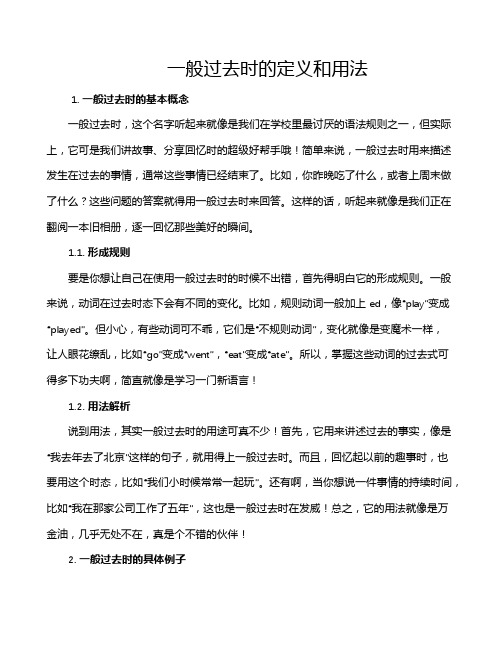
一般过去时的定义和用法1. 一般过去时的基本概念一般过去时,这个名字听起来就像是我们在学校里最讨厌的语法规则之一,但实际上,它可是我们讲故事、分享回忆时的超级好帮手哦!简单来说,一般过去时用来描述发生在过去的事情,通常这些事情已经结束了。
比如,你昨晚吃了什么,或者上周末做了什么?这些问题的答案就得用一般过去时来回答。
这样的话,听起来就像是我们正在翻阅一本旧相册,逐一回忆那些美好的瞬间。
1.1. 形成规则要是你想让自己在使用一般过去时的时候不出错,首先得明白它的形成规则。
一般来说,动词在过去时态下会有不同的变化。
比如,规则动词一般加上ed,像“play”变成“played”。
但小心,有些动词可不乖,它们是“不规则动词”,变化就像是变魔术一样,让人眼花缭乱,比如“go”变成“went”,“eat”变成“ate”。
所以,掌握这些动词的过去式可得多下功夫啊,简直就像是学习一门新语言!1.2. 用法解析说到用法,其实一般过去时的用途可真不少!首先,它用来讲述过去的事实,像是“我去年去了北京”这样的句子,就用得上一般过去时。
而且,回忆起以前的趣事时,也要用这个时态,比如“我们小时候常常一起玩”。
还有啊,当你想说一件事情的持续时间,比如“我在那家公司工作了五年”,这也是一般过去时在发威!总之,它的用法就像是万金油,几乎无处不在,真是个不错的伙伴!2. 一般过去时的具体例子我们来聊聊一些生动的例子吧,让大家更直观地感受一下一般过去时的魅力。
想象一下,你跟朋友在聊天,突然问:“嘿,你上次旅行去哪儿了?”朋友兴奋地回答:“哦,我去年去的那个小岛简直太美了!”听,这个“去了”就是一般过去时,立刻把你带回了那个阳光灿烂的假期。
然后,朋友接着说:“我们每天都在海滩上晒太阳,还吃了很多海鲜。
”你是不是感觉像是在旁边看他们的旅行录像?没错,这就是一般过去时的魔力。
2.1. 叙述过去的故事一般过去时还特别适合讲故事。
试想一下,若你想给朋友分享一个搞笑的故事:“那天我走在路上,突然看到一只狗追着一只猫,结果猫跳上了树,狗却撞上了电线杆!”哇,这个故事可真有趣,且所有的动作都用了一般过去时,听起来流畅又自然,仿佛你正在给大家讲一个生动的情景。
小学一般过去时ppt课件

常与表示过去的时间状语连用
如yesterday, last week等。
2024/1/26
8
肯定句使用场景举例
1 2
描述过去发生的事情
如"I went to the park yesterday."(我昨天去 了公园)。
表达过去的习惯或经常性动作
如"She always walked to school when she was young."(她年轻时总是步行去学校)。
5
时间状语及标志词
2024/1/26
时间状语
yesterday,last week,an hour ago等。
标志词
ago(以前),just now(刚才 ),then(那时)等。
6
PART 02
肯定句结构与用法
REPORTING
2024/1/26
7
肯定句结构特点
主语 + 动词过去式
表示过去某个时间发生的动作或状态。
式。
注意动词变化
掌握规则动词和不规则动词的 过去式变化,避免使用时出现
错误。
结合语境理解
在阅读和听力练习中,结合上 下文语境理解一般过去时的用
法。
模仿和练习
通过模仿和练习,逐渐熟练掌 握一般过去时的运用技巧。
2024/1/26
26
THANKS
感谢观看
REPORTING
2024/1/26
27
疑问句句尾语调上升。
2024/1/26
16
疑问句使用场景举例
对过去发生的事情进行提问。
2024/1/26
对过去某个时间点的状态进行 提问。
对过去某个时间段内发生的动 作进行提问。
一般过去时讲解PPT课件

did
助动词,用于构成一般过去时的 疑问句和否定句。
主语
句子中的动作执行者,可以是名 词、代词等。
例如
What did you do yesterday? 你 昨天做了什么?
其他成分
包括宾语、状语等,根据句子需 要而定。
动词原形
指动词的基本形式,即不加任何 时态或语态标记的形式。
特殊疑问句实例分析
when、after、 before、as等引导的 表示过去的时间状语 从句。
已经、曾经、刚才、 那时等表示过去的时 间副词。
02
一般过去时肯定句结构
主语+动词过去式+其他成分
01
02
03
主语
句子中的主体,可以是人 、物或抽象概念。
动词过去式
表示过去某个时间里发生 的动作或状态。动词的过 去式可分为规则变化和不 规则变化两种。
表示过去某个时间里发生的动 作或状态。
用法
陈述过去的事实或情况,描述 过去经常或反复发生的动作。
现在完成时
表示过去发生的动作对现在造 成的影响或结果,或从过去已 经开始,持续到现在的动作或 状态。
用法
强调过去与现在的联系,表达 一个动作从过去一直延续到现
在。
两者在时间状语上的区别
01
02
03
04
一般过去时
一般过去时讲解PPT课件
目录 Contents
• 一般过去时基本概念 • 一般过去时肯定句结构 • 一般过去时否定句结构 • 一般过去时疑问句结构 • 一般过去时特殊疑问句结构 • 一般过去时与现在完成时的比较
01
一般过去时基本概念
定义与作用
定义
一般过去时表示过去某个时间里 发生的动作或状态。
一般过去时
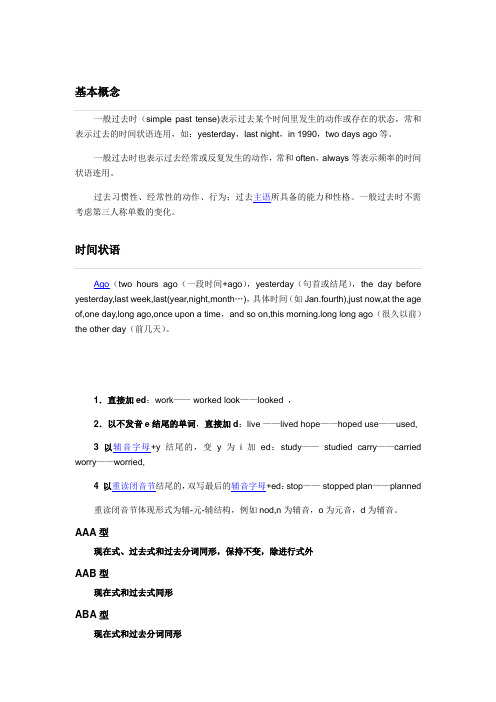
基本概念一般过去时(simple past tense)表示过去某个时间里发生的动作或存在的状态,常和表示过去的时间状语连用,如:yesterday,last night,in 1990,two days ago等。
一般过去时也表示过去经常或反复发生的动作,常和often,always等表示频率的时间状语连用。
过去习惯性、经常性的动作、行为;过去主语所具备的能力和性格。
一般过去时不需考虑第三人称单数的变化。
时间状语Ago(two hours ago(一段时间+ago),yesterday(句首或结尾),the day before yesterday,last week,last(year,night,month…),具体时间(如Jan.fourth),just now,at the age of,one day,long ago,once upon a time,and so on,this morning.long long ago(很久以前)the other day(前几天)。
1.直接加ed:work—— worked look——looked ,2.以不发音e结尾的单词,直接加d:live ——lived hope——hoped use——used,3 以辅音字母+y结尾的,变y为i加ed:study——studied carry——carried worry——worried,4 以重读闭音节结尾的,双写最后的辅音字母+ed:stop—— stopped plan——planned重读闭音节体现形式为辅-元-辅结构,例如nod,n为辅音,o为元音,d为辅音。
AAA型现在式、过去式和过去分词同形,保持不变,除进行式外AAB型现在式和过去式同形ABA型现在式和过去分词同形ABB型过去式与过去分词同形分为以下情形:①在动词原形后加一个辅音字母d或t。
②把动词原形的最后一个辅音字母“d”改为“t”。
一般过去时_小学六年级英语
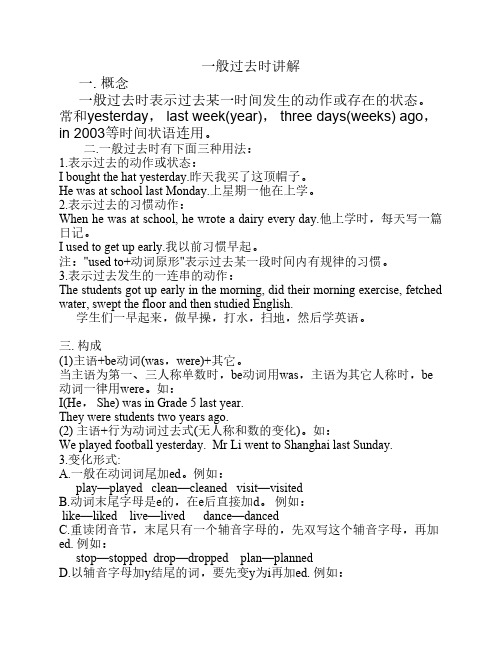
一般过去时讲解一. 概念一般过去时表示过去某一时间发生的动作或存在的状态。
常和yesterday, last week(year), three days(weeks) ago,in 2003等时间状语连用。
二.一般过去时有下面三种用法:1.表示过去的动作或状态:I bought the hat yesterday.昨天我买了这顶帽子。
He was at school last Monday.上星期一他在上学。
2.表示过去的习惯动作:When he was at school, he wrote a dairy every day.他上学时,每天写一篇日记。
I used to get up early.我以前习惯早起。
注:"used to+动词原形"表示过去某一段时间内有规律的习惯。
3.表示过去发生的一连串的动作:The students got up early in the morning, did their morning exercise, fetched water, swept the floor and then studied English.学生们一早起来,做早操,打水,扫地,然后学英语。
三. 构成(1)主语+be动词(was,were)+其它。
当主语为第一、三人称单数时,be动词用was,主语为其它人称时,be 动词一律用were。
如:I(He, She) was in Grade 5 last year.They were students two years ago.(2) 主语+行为动词过去式(无人称和数的变化)。
如:We played football yesterday. Mr Li went to Shanghai last Sunday.3.变化形式:A.一般在动词词尾加ed。
例如:play—played clean—cleaned visit—visitedB.动词末尾字母是e的,在e后直接加d。
一般过去时
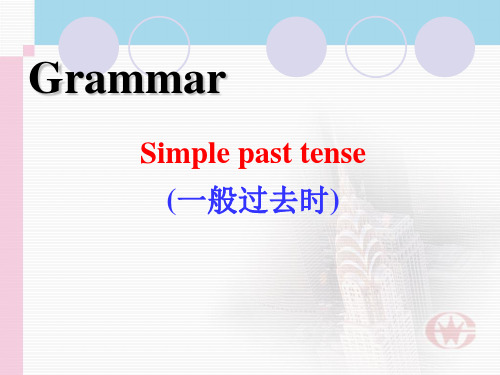
Was/were +主语+其他?
Was he happy yesterday? -Yes, he was./No, he wasn’t. Were they in the classroom? -Yes, they were./No, they weren’
含有行为动词的一般过去时: I go to school every day. I went to school yesterday. He did his home work yesterday.
一般过去时的结构
• 含有be动词的一般过去时 • 含有实义动词(行为动词)的一般过去时 • 含有情态动词的一般过去时
一、含有be动词的一般过去时
刘翔现在31岁。
Liu Xiang is ___ 31 years old now.
刘翔2004年21岁。
Liu Xiang was ____ 21 ye有be动词的一般过去时
我今年12岁。 am I _______ twelve years old this year. 我去年11岁。
I ________ was eleven years old last year.
他每天在家。 He is at home every day . 他昨天在家。 He was at home yesterday .
常与一般过去时态连用的时间有:
①yesterday, yesterday morning, the day before yesterday ②last night last week, last month, last year… ③two days ago, three years ago… a moment ago=just now(刚才) ④in 1990, (in 1998…) ⑤this morning, this Monday ⑥When I was 5 years old
一般过去时用法及概念

一般过去时的用法及概念在英语语法中,一般过去时是一个重要的时间表达方式。
它主要用于描述过去发生的事情,或者在过去某个特定时间点完成的动作。
理解和掌握一般过去时的用法和概念对于提高英语水平具有重要意义。
一、一般过去时的概念一般过去时是一种动词时态,表示在过去某个时间或时间段内发生的动作或存在的状态。
这个时态的主要标志是动词的一般过去式形式,即动词原形后面加-ed。
二、一般过去时的用法1. 描述过去的事实或情况:例如,“Yesterday, I went to the park.”(昨天,我去了公园。
)2. 表示过去习惯性的动作:例如,“When I was a child, I always played football with my friends after school.”(当我还是个孩子的时候,放学后我总是和朋友们一起踢足球。
)3. 用于叙述故事或讲述过去的历史事件:例如,“In 1969, Neil Armstrong walked on the moon for the first time in human history.”(1969年,尼尔·阿姆斯特朗首次在人类历史上在月球上行走。
)三、一般过去时的构成一般过去时通常由主语+动词的一般过去式+宾语组成。
动词的一般过去式是在动词原形的基础上加上-ed。
但需要注意的是,有些不规则动词的过去式形式需要特殊记忆,例如go的过去式是went,eat的过去式是ate等。
四、一般过去时的否定句和疑问句在一般过去时的否定句中,我们使用助动词did not(didn't)+动词原形。
例如,“I didn't eat breakfast this morning.”(今天早上我没有吃早餐。
)在一般过去时的疑问句中,我们同样使用助动词did,将did提到主语之前。
例如,“Did you go to the party last night?”(你昨晚去参加聚会了吗?)。
一般过去时的概念
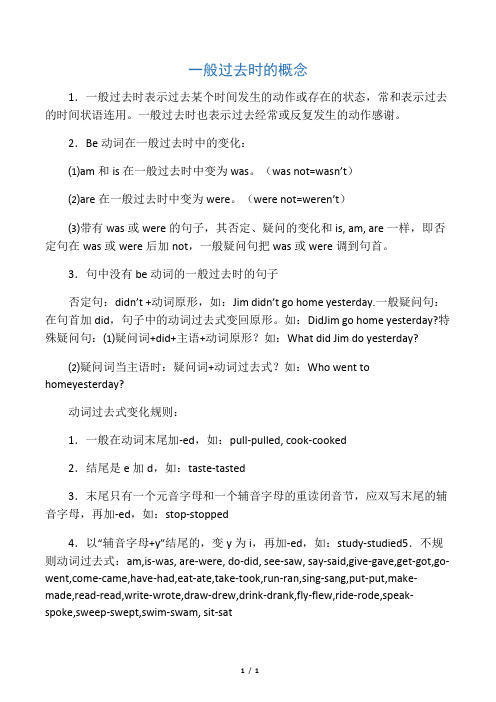
一般过去时的概念1.一般过去时表示过去某个时间发生的动作或存在的状态,常和表示过去的时间状语连用。
一般过去时也表示过去经常或反复发生的动作感谢。
2.Be动词在一般过去时中的变化:⑴am和is在一般过去时中变为was。
(was not=wasn’t)⑵are在一般过去时中变为were。
(were not=weren’t)⑶带有was或were的句子,其否定、疑问的变化和is, am, are一样,即否定句在was或were后加not,一般疑问句把was或were调到句首。
3.句中没有be动词的一般过去时的句子否定句:didn’t +动词原形,如:Jim didn’t go home yesterday.一般疑问句:在句首加did,句子中的动词过去式变回原形。
如:DidJim go home yesterday?特殊疑问句:⑴疑问词+did+主语+动词原形?如:What did Jim do yesterday?⑵疑问词当主语时:疑问词+动词过去式?如:Who went to homeyesterday?动词过去式变化规则:1.一般在动词末尾加-ed,如:pull-pulled, cook-cooked2.结尾是e加d,如:taste-tasted3.末尾只有一个元音字母和一个辅音字母的重读闭音节,应双写末尾的辅音字母,再加-ed,如:stop-stopped4.以“辅音字母+y”结尾的,变y为i,再加-ed,如:study-studied5.不规则动词过去式:am,is-was, are-were, do-did, see-saw, say-said,give-gave,get-got,go-went,come-came,have-had,eat-ate,take-took,run-ran,sing-sang,put-put,make-made,read-read,write-wrote,draw-drew,drink-drank,fly-flew,ride-rode,speak-spoke,sweep-swept,swim-swam, sit-sat1/ 1。
一般过去时的用法及结构笔记
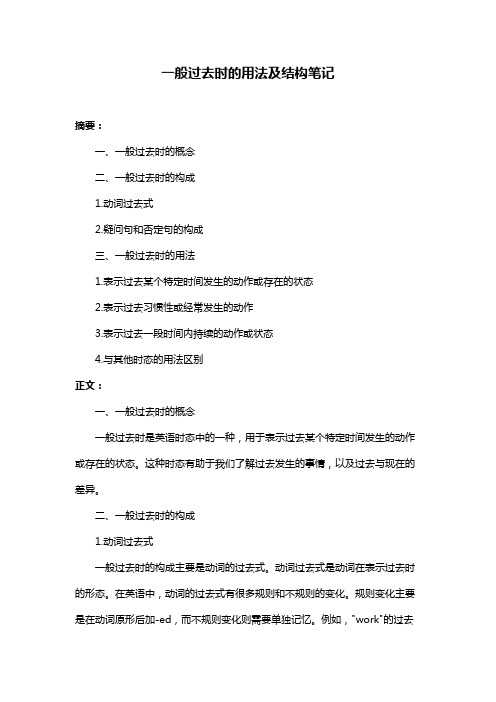
一般过去时的用法及结构笔记摘要:一、一般过去时的概念二、一般过去时的构成1.动词过去式2.疑问句和否定句的构成三、一般过去时的用法1.表示过去某个特定时间发生的动作或存在的状态2.表示过去习惯性或经常发生的动作3.表示过去一段时间内持续的动作或状态4.与其他时态的用法区别正文:一、一般过去时的概念一般过去时是英语时态中的一种,用于表示过去某个特定时间发生的动作或存在的状态。
这种时态有助于我们了解过去发生的事情,以及过去与现在的差异。
二、一般过去时的构成1.动词过去式一般过去时的构成主要是动词的过去式。
动词过去式是动词在表示过去时的形态。
在英语中,动词的过去式有很多规则和不规则的变化。
规则变化主要是在动词原形后加-ed,而不规则变化则需要单独记忆。
例如,"work"的过去式是"worked",而"go"的过去式是"went"。
2.疑问句和否定句的构成一般过去时的疑问句构成是:Did + 动词过去式+ 主语+ 其他成分?例如:Did you go to the park yesterday?(昨天你去公园了吗?)一般过去时的否定句构成是:主语+ 动词过去式+ 其他成分。
例如:I didn"t watch TV last night.(我昨晚没看电视。
)三、一般过去时的用法1.表示过去某个特定时间发生的动作或存在的状态一般过去时主要用于描述过去某个特定时间发生的动作或存在的状态。
例如:I ate breakfast at 7 o"clock this morning.(我今天早上七点吃了早餐。
)2.表示过去习惯性或经常发生的动作一般过去时还可以用来表示过去习惯性或经常发生的动作。
例如:I used to go to the park every weekend.(我过去常常每个周末去公园。
)3.表示过去一段时间内持续的动作或状态一般过去时也可以用来表示过去一段时间内持续的动作或状态。
- 1、下载文档前请自行甄别文档内容的完整性,平台不提供额外的编辑、内容补充、找答案等附加服务。
- 2、"仅部分预览"的文档,不可在线预览部分如存在完整性等问题,可反馈申请退款(可完整预览的文档不适用该条件!)。
- 3、如文档侵犯您的权益,请联系客服反馈,我们会尽快为您处理(人工客服工作时间:9:00-18:30)。
一般过去时的概念
1.一般过去时表示过去某个时间发生的动作或存在的状态,常和表示过去的时间状语连用。
一般过去时也表示过去经常或反复发生的动作感谢。
2.Be动词在一般过去时中的变化:
⑴am 和is在一般过去时中变为was。
(was not=wasn’t)
⑵are在一般过去时中变为were。
(were not=weren’t)
⑶带有was或were的句子,其否定、疑问的变化和is, am, are一样,即否定句在was或were后加not,一般疑问句把was或were调到句首。
3.句中没有be动词的一般过去时的句子
否定句:didn’t +动词原形,如:Jim didn’t go home yesterday.
一般疑问句:在句首加did,句子中的动词过去式变回原形。
如:Did Jim go home yesterday? 特殊疑问句:⑴疑问词+did+主语+动词原形?如:What did Jim do yesterday?
⑵疑问词当主语时:疑问词+动词过去式?如:Who went to home yesterday?
动词过去式变化规则:
1.一般在动词末尾加-ed,如:pull-pulled, cook-cooked
2.结尾是e加d,如:taste-tasted
3.末尾只有一个元音字母和一个辅音字母的重读闭音节,应双写末尾的辅音字母,再加-ed,如:stop-stopped
4.以“辅音字母+y”结尾的,变y为i,再加-ed,如:study-studied 5.不规则动词过去式:am,is-was, are-were, do-did, see-saw, say-said, give-gave, get-got, go-went, come-came, have-had, eat-ate, take-took, run-ran, sing-sang, put-put, make-made, read-read, write-wrote, draw-drew, drink-drank, fly-flew, ride-rode, speak-spoke, sweep-swept, swim-swam, sit-sat。
